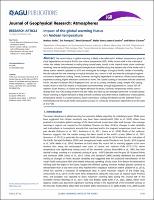| dc.contributor.author | Vuille, M. | |
| dc.contributor.author | Franquist, E. | |
| dc.contributor.author | Garreaud, R. | |
| dc.contributor.author | Lavado-Casimiro, W. | |
| dc.contributor.author | Cáceres, B. | |
| dc.date.accessioned | 2019-07-27T23:56:45Z | |
| dc.date.available | 2019-07-27T23:56:45Z | |
| dc.date.issued | 2015-08 | |
| dc.identifier.uri | http://repositorio.senamhi.gob.pe/handle/20.500.12542/96 | |
| dc.description.abstract | The recent hiatus in global warming is likely to be reflected in Andean temperature, given its close dependence on tropical Pacific sea surface temperature (SST). While recent work in the subtropical Andes has indeed documented a cooling along coastal areas, trends in the tropical Andes show continued warming. Here we analyze spatiotemporal temperature variability along the western side of the Andes with a dense station network updated to 2010 and investigate its linkages to tropical Pacific modes of variability. Results indicate that the warming in tropical latitudes has come to a halt and that the subtropical regions continue to experience cooling. Trends, however, are highly dependent on elevation. While coastal regions experience cooling, higher elevations continue to warm. The coastal cooling is consistent with the observed Pacific Decadal Oscillation (PDO) fingerprint and can be accurately simulated using a simple PDO-analog model. Much of the PDO imprint is modulated and transmitted through adjustments in coastal SST off western South America. At inland and higher-elevation locations, however, temperature trends start to diverge from this PDO-analog model in the late 1980s and have by now emerged above the 1σ model spread. Future warming at higher elevation is likely and will contribute to further vertical stratification of atmospheric temperature trends. In coastal locations, future warming or cooling will depend on the potential future intensification of the South Pacific anticyclone but also on continued temperature dependence on the state of the PDO. | en_US |
| dc.format | application/pdf | |
| dc.language.iso | eng | en_US |
| dc.publisher | Wiley-Blackwell | en_US |
| dc.relation.ispartof | urn:issn:0148-0227 | |
| dc.rights | info:eu-repo/semantics/openAccess | es_PE |
| dc.rights | Attribution-NonCommercial-ShareAlike 3.0 United States | * |
| dc.rights.uri | http://creativecommons.org/licenses/by-nc-sa/3.0/us/ | * |
| dc.source | Servicio Nacional de Meteorología e Hidrología del Perú | es_PE |
| dc.source | Repositorio Institucional - SENAMHI | es_PE |
| dc.subject | Anticyclone | en_US |
| dc.subject | Atmospheric modeling | en_US |
| dc.subject | Cambio Climático | en_US |
| dc.subject | Coastal zone | en_US |
| dc.subject | Cooling | en_US |
| dc.subject | Global warming | en_US |
| dc.subject | Pacific Decadal Oscillation | en_US |
| dc.subject | Sea surface temperature | en_US |
| dc.subject | Spatiotemporal analysis | en_US |
| dc.subject | Temperature effect | en_US |
| dc.subject | Temperature inversion | en_US |
| dc.subject | Andes | |
| dc.title | Impact of the global warming hiatus on Andean temperature | en_US |
| dc.type | info:eu-repo/semantics/article | en_US |
| dc.identifier.isni | 0000 0001 0746 0446 | |
| dc.description.peerreview | Por pares | |
| dc.identifier.doi | https://doi.org/10.1002/2015JD023126 | |
| dc.source.volume | 120 | es_PE |
| dc.source.issue | 9 | es_PE |
| dc.source.initialpage | 3745 | es_PE |
| dc.source.endpage | 3757 | es_PE |
| dc.source.journal | Journal of Geophysical Research | es_PE |
| dc.subject.sinia | temperatura - Clima y Eventos Naturales | |
| dc.type.sinia | text/publicacion cientifica | |
| dc.identifier.url | https://hdl.handle.net/20.500.12542/96 | |









